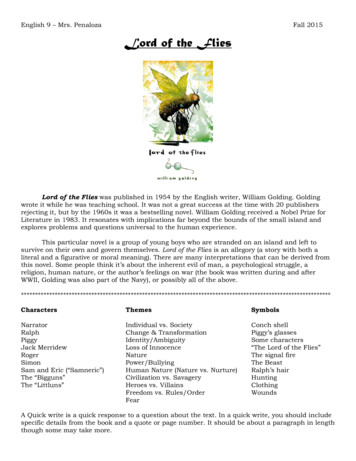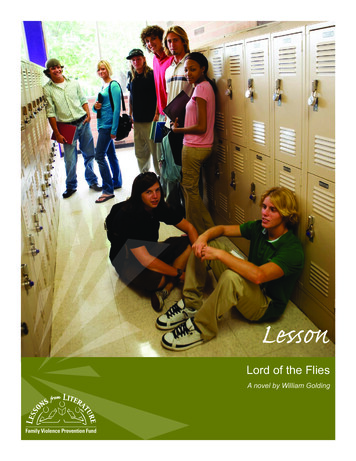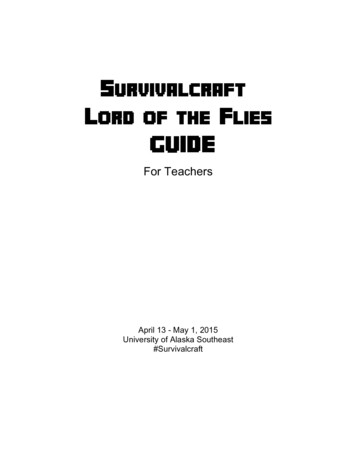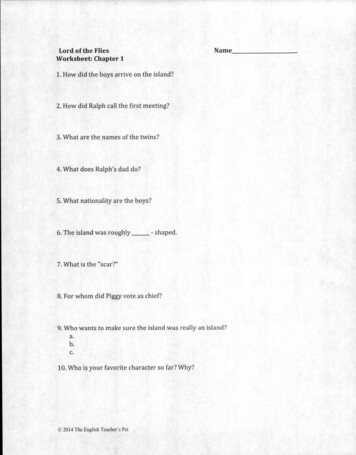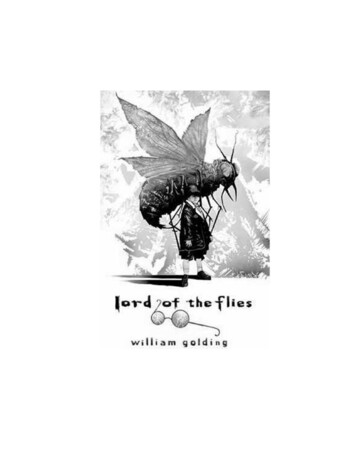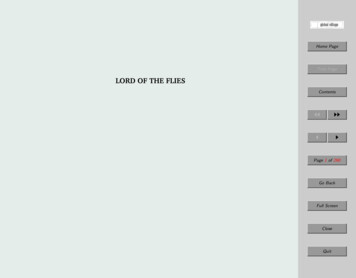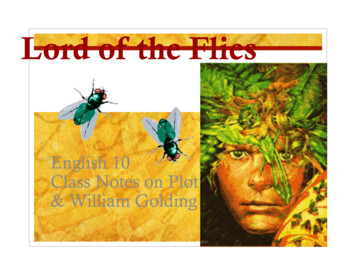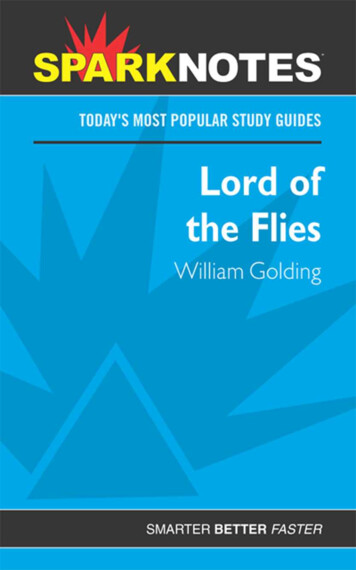
Transcription
MissCrossA1629593Lord of The Flies UnitMiss CrossStage 1 English2016 Term 2Overview of Unit: Text response to William Golding’s 1954, Lord of the FliesPrevious Unit: Oral language based unitSubsequent Unit: Intertextuality literary based unitPrerequisites & Assumed Knowledge: English completion at a year 10 level. Read “Lord of the Flies” over the two week holiday period.Learning Aims & Objectives of Unit: Challenge students’ moral positions and individual values in regards to thedystopian imagery presented in Lord of the Flies and its effects upon choices,communities, rules, hegemony and reality.Educational Standards Addressed: KU1, KU2, AN2, AP2, AP3, C1, C2Assessment Type: Text response- argumentative essay (up to 800 words)1
MissCrossA1629593Lesson 1: Stage 1 English 2016 Term 2 Week 1Focus/Topic/Title: Introduction to Lord of the FliesEssential Questions: What are your positions andindividual values when it comes tothe dystopia presented in Lord of theFlies?Grade:Duration:Year 1150 MinutesObjectives/Learning Outcomes:Assessment: entstoputtheseintopracticewithoneanother.Lesson Format:Time: Introduction: discussion about holidays and where the class is all at inregards to reading their assigned novel. Starter remembering game: students will be arranged into a circle andwill be instructed to each decide upon one thing they would take withthem if they were stranded on a desert island. One student will beginthen the next student will have to say both items said and thencontinued around the circle. For example, “If I was stranded on adesert island I would choose to bring water and sun block, etc.” Game follow-up activity: I will select 4 leaders and ask them to eachchoose students based on what that particular student chose to bring tothe island and then in groups apply Edward de Bono’s Worksheet(Appendix A) to aid group discussions about each group’s individualisland experience.(Hunter 2013)Resources and Materials: Lord of the Flies novel Edward de Bono WorksheetHomework and Practice: Re-reading chapter 1 of the novelwith an emphasis on the themesdiscussed today. Formative 3-5 minutes 10-15minutes 25-30minutesDifferentiation: Provide spare copies for any students’ whomay have misplaced their novel. Can discuss de Bono’s Worksheet questionsinstead of writing them down.Differentiation: Assign specific pages to students’ that arestruggling to keep up to focus on. Provide large print version of novel.2
MissCrossA1629593Lesson Closing/Plenary: Group Discussion: brainstorming questions written below the Blooms worksheet.Lesson 2: Stage 1 English 2016 Term 2 Week 1Focus/Topic/Title: Introduction to Lord of the FliesEssential Questions: How does William Golding usesymbolic techniques in his novelLord of the Flies?Grade:Duration:Year 1150 MinutesObjectives/Learning Outcomes:Assessment: theassignedtext.Lesson Format:Time: Starter: Using a projector, I will project a series of optical illusionpictures (Appendix B) to challenge the class’s visual thinkingprocesses and discuss as a class what we interpret the images as.(Google 2016) Activity: I will put 4 more images (Appendix B) on the projector forthe class to view and have a brief discussion about each and itsrelation to Lord of the Flies, before distributing an individualworksheet for the class to complete (Appendix C). (Google 2016) Individual work time: I will be walking around the class assisting asmany students one on one as possible in regards to their individualunderstandings of the symbols used in Lord of the Flies.Resources and Materials: Lord of the Flies novelProjectorMicrosoft PowerPointStudent Laptops/iPadsWorksheet (Appendix C)Homework and Practice: Continuing with the worksheet untilat least one point is made for eachsection is complete. Joining the class’s Edmodo &viewing attached material. Formative 5 minutes 30 minutes 10 minutesDifferentiation: Provide printed copies of the images for anystudents that have difficulty viewing contentfrom the projector. If students are really having trouble, they canwork with in an assigned pair.Differentiation: If students are more comfortable discussingwith me rather than writing it down then I willaccept that if I deem it a sufficient answer. If any students wish to work more on this task3after class hours, I will make time for themduring recess or lunch to further assist.
MissCrossA1629593Lesson Closing/Plenary: For the remaining 5 minutes of the class I will ask the class to each join the class’s Edmodoonline group that I will have set up specifically for the Lord of the Flies unit. Here I will attacha video relevant to the class’s current work on the novel and also upload video content thatbriefly describes the plot, this will cater to the learner’s that prefer visual content. For anyenthusiastic learners/achievers, I would encourage them to source content of their own that isrelevant for the class and ask them to upload their findings to the group’s Edmodo site.Useful websites to add to Edmodo: http://www.shmoop.com/lord-of-the-flies/ http://www.aipsych.org.au/articles/aip4-lord of the flies.pdf http://www.bbc.co.uk/schools/gcsebitesize/english literature/proselordflies/(Hunter 2013)In Between Lessons:Week 1: Lesson 3 (90 minutes):Class focused on referencing techniques and how and why it is necessary.Class learnt how to reference from different sources and practiced withparaphrasing and direct quoting.Week 2: Lesson 1 (50 minutes):Class was introduced to their summative assessment for this unit, anargumentative essay of up to 800 words (Appendix D) (Hunter 2013 p. 22).Students were taught about what an argumentative essay is and the processesinvolved when writing one. Students practiced with simple ideas regarding thepresentation of dystopia and drafted practice essay drafts before beginning toorganize their ideas for the summative task. Lesson 2 (50 minutes):Class was re-introduced to the rubric system used for Stage 1 English(Appendix E) and taken through the grading system step by step. Students’worked on their essay plans aiming to improve with regards to the standardsset by the rubric (SACE 2016).4
MissCrossA1629593Lesson 3: Stage 1 English 2016 Term 2 Week 2Focus/Topic/Title: Lord of the Flies Character AnalysisEssential Questions: Do the characters’ individual choicesand decisions reflect theirpersonalities? What do you baseyour decisions upon?Grade:Duration:Year 1190 minutesObjectives/Learning OutcomesAssessment: Students will be able to think deeper about each character and be ableto build complex contrasts between them all in relation to specificthemes explored throughout Lord of the Flies and the effect eachcharacters’ role has upon the story and its audience.Lesson Format:Time: Starter: “Call my Bluff”: 4 students are given a word. One has thecorrect definition and the others make up definitions. The other teamhas to work out which is the correct definition (Hunter 2013 p. 136). Activity: Class will be divided into 3 groups that each represent acharacter and view the time on the island from their point of view(Jack, Ralph and an audience of adult judges: parents, police, etc).The Jack and Ralph group will discuss as small groups the questionsfrom the relevant worksheet (Appendix F) and the adult audiencegroup will devise a number of questions that will enable them to passjudgment upon groups’ Jack and Ralph’s decisions. The questionsdevised by the “adults” must elicit objective and subjective answers. Presentation: Class will come back together and the room will beadjusted to reflect a courthouse. The adult audience group willinterrogate the Jack & Ralph group and then formulate theirconclusion based on their gathered evidence and decide if anypunishments (stay in class an extra 3 minutes) or rewards (earlyminute) should be given out. Individual working time on summative task: argumentative essay.Resources and Materials: Props to easily identify and separatethe Jack, Ralph & adult audiencegroups Worksheet (Appendix F) White board and/or interactive whiteboard Craft materials for students wanting Formative 3-5 minutes 20 minutes 30-40minutes 15 minutesDifferentiation: Instead of the entire group speaking to answerthe audiences’ questions or creating questionsfor the Jack and Ralph group, each groupcould elect one speaker who feels moreconfident. If the room was too small for the task at hand,I could move our class to the oval for a changein scenery and have an outdoors component to5
MissCrossA1629593to reflect their groups’ ideas upon aposter Lord of the Flies novelHomework and Practice: Students can write a 150-200 wordsummary of what they think Jackand Ralph represent and whichleader they would choose to followand why? Provide evidence. Students must reflect upon theirargumentative essays in regards totheir chosen content, analysis andevidence to support their ideas ontheir presentation of dystopia.my lesson. The change of space could allowthe students to feel more relaxed andcomfortable in a natural environment.Differentiation: Students could make a podcast or aPowerPoint presentation to do this homeworkif they felt they needed more multimodal toolsto explain their decisions and findings. In the final 15 minutes of the class duringindividual working time, I will be walkingaround the room discussing essay layout andideas one on one with students.Lesson Closing/Plenary: For the remaining 5-10 minutes of the class I will reiterate to the students that their draftArgumentative Essay is due at the beginning of the next lesson. I will ask the students’ toreflect individually on what we have learnt about Lord of the Flies including: themes: choices,hegemony, communities and rules, aspects of symbolism and complex character contrasts. Iwill also ask students’ to reflect upon lessons we had on correct referencing and how to writean argumentative essay. To finish, I will state that I look forward to seeing their completed drafted essays next lessonthat I will review ONCE before returning it to them to edit and hand up by the end of theweek.6
MissCrossA1629593Lesson 1: Stage 1 English 2016 Term 2 Week 3Focus/Topic/Title: Essay Editing and ReflectionEssential Questions: In the essay: What are you talkingabout? How do you know this? Sowhat? (Hunter 2013 p. 22).Grade:Duration:Year 1150 MinutesObjectives/Learning Outcomes:Assessment: Students will gain confidence and editing skills via practice withpeers before applying that knowledge to their individual summativetasks.Lesson Format: SummativeTime: Starter: “Word grids”- Create a grid that’s square. In column one putadjectives and in top row put nouns. Get the students to blend the twoto create noun phrases. To vary this, use nouns and adverbs to createverb phrases (Hunter 2013 p. 136). Editing task: students will get into pairs and edit one another’s essayswith a different coloured pen using the Stage 1 English rubric(Appendix E) and Argumentative Essay outline (Appendix D). Individual essay editingResources and Materials: Lord of the Flies novelWhite board/interactive white boardDifferent coloured pensStudent laptops/computersHomework and Practice: Optional: reflect upon the work wehave done thus far and list ways inwhich you hope you improve yourpresentation of dystopia in youressay. 5 minutes 20-30minutes 15 minutesDifferentiation: Students can choose to edit their own essayindividually instead of with a peer. Provide spare copies for any students’ whomay have misplaced their novel. Provide large print versions of the text. Could book the IT room in the school for thislesson to give the students a different learningenvironment for a change.Differentiation: Extended reading on other texts by WilliamGolding. Practiced character role-playing with peers.Lesson Closing/Plenary: I will collect their drafted essays and return them in the next couple of days.7
MissCrossA1629593 Remaining 5 minutes: Kahoot quiz online that will challenge what the students’ can rememberfrom all that we have learnt throughout this unit. The quiz will also be a fun and interactiveend to what may have been a stressful lesson for some (Kahoot 2016).Follow-up Lessons:Week 3: Lesson 2 (50 minutes):Introduction to the next assessment task for the term, an intertextual study. Iwill return their drafted essays at the end of the lesson and expect them to becompleted and finished by the end of the next lesson. Lesson 3 (90 minutes):Students will work on their individual summative essays and hand them in bythe end of the lesson.8
MissCrossA1629593APPENDIX AApplying Edward de Bono’s Thinking HatsIn your groups, identify how each aspect of de Bono’s thinking applies to your group inregards to your individual items you each selected for the island.Red- Feelings/EmotionsWhite- Information/FactsYellow- Benefits/ValuesBlack- Difficulties/WeaknessesGreen- Creative Ideas/AlternativesBlue- Summary/Focus(Hunter 2013 p. 137).Brainstorming Questions:1. Choices: How we make them, what they are, how they are determined by society andcircumstance?2. Hegemony: How it is obtained, managed and its effect?3. Communities: How they are created, defined and their effects on individuals?4. Rules: Relevance, impact and power in our lives?9
MissCrossA1629593APPENDIX BOptical Illusion Images:Lord of the Flies Images:1.2.3.4.(Google 2016)10
MissCrossA1629593APPENDIX CWorksheetImageHow does thisimage relate tothe themes inLord of theFlies?Is there aquotation in thebook that showsthis? Providepage reference.How does thisimageaffect/deepenmyunderstandingof the plot?What is theeffect of thisimage on thetext as a whole?What is theeffect of thisimage andassociatedthemes on theaudience?1234(Hunter 2013 p. 21).11
MissCrossA1629593Appendix DConstructing your essay:This is an argumentative essay where you express your opinion, with evidence and analysis.To do this you need to utilize either the:Point – Quotation – Analysisor thePremise – Reason – Interim Conclusion/Premise – Reason – Conclusionpattern of essay construction.Your point or premise is your topic sentence/key idea which are you going to explore. It answers the question ‘what are you talking about?’.Your quotation/reason is the evidence from the text which has given you this idea and whichyou are about to analyse. It answers the ‘how do you know this?’.Your interim conclusion is your analysis of your quotation and its location in the ideassequence.Your analysis/conclusion is your explanation of the effect of this key idea on the character,the text as a whole and the audience. It answers the question ‘so what?’.Remember that your focus throughout the essay is on the presentation of dystopia. Whatever examples you choose to analyse, both character-wise and symbol-wise,must move forward your argument about dystopia. I would therefore choose charaterswho have many divergent characteristics, for example one who starts off asessentially good and one who starts off as essentially self-serving, to enable you tohave complex contrasts to discuss.Your word limit is 800 words at Stage 1, so you need to be very precise.Planning your answer carefully before you write will make this process far easier to manage.Remember to keep your tone objective and formal: avoid “I” on the first person sentences.Be careful to avoid sweeping statements: this text explores ideas, it doesn’t offer polemic orpropaganda, as such.Drafts can be sent at any point, including the planning stage: sending in draft means I canhelp you individually with structure, register and idea development.(Hunter 2013 p. 22)12
MissCrossA1629593Appendix EPerformance Standards for Stage 1 EnglishKnowledge and UnderstandingAnalysisA Detailed knowledge and understanding ofPerceptive evaluation of theideas and perspectives explored in a diverse complex relationship betweenrange of texts.purpose, audience, and context andhow they shape meaning.Extensive knowledge and understanding ofthe variety of language features, stylisticInsightful analysis of how languagefeatures, and conventions authors use tofeatures, stylistic features, andmake meaning.conventions combine to influencereaders in various text types.Comprehensive knowledge andunderstanding of ways in which texts areAnalysis of complex intertextualcreated for a range of purposes andconnections between different texts.audiences.B Knowledge and understanding of ideas andperspectives explored in a range of texts.Knowledge and understanding of a range oflanguage features, stylistic features, andconventions authors use to make meaning.Knowledge and understanding of ways inwhich texts are created for a range ofpurposes and audiences.Effective analysis of the relationshipbetween purpose, audience, andcontext and how they shapemeaning.Analysis of how language features,stylistic features, and conventionsinfluence readers in various texttypes.Analysis of intertextual connectionsbetween different texts.C Knowledge and understanding of ideas andDescription, with some analysis ofpurpose, audience, and context andhow they shape meaning.Knowledge and understanding of somelanguage features, stylistic features, andconventions authors use to make meaning.Description, with some analysis, ofhow language features, stylisticfeatures, and conventions influencereaders in some text types.some perspectives explored in a range oftexts.Knowledge and understanding of ways inwhich texts are created for familiar purposesand audiences.D Reference to simple ideas explored in texts.Knowledge and understanding of a narrowrange of language features and conventionsauthors use to make meaning.Recognition of a restricted range oflanguage features used by authors.Acknowledgment of one or more ways inwhich texts are created for a purpose or anaudience.Fluent and precise writing andspeaking.Sophisticated use of appropriatelanguage features, stylistic features,and conventions for a range ofaudiences and purposes.Detailed and appropriate use ofevidence from texts to supportconclusions, with textual referencesintegrated into responses.Mostly fluent and precise writingand speaking.Use of accurate language features,stylistic features, and conventionsfor a range of audiences andpurposes.Accurate use of evidence from textsto support conclusions, with textualreferences incorporated fluently inresponses.Generally fluent and accuratewriting and speaking.Use of language features, stylisticfeatures, and conventionsappropriate for familiar audiencesand purposes.Description, with some analysis ofintertextual connections betweendifferent texts.Use of evidence from texts tosupport conclusions, with sometextual references incorporated inresponses.Identification of the purpose,audience, and context of texts.Some control and fluency ofexpression.Reference to some ways in whichconventions and language featuresinfluence readers in some textKnowledge and understanding of a restricted types.range of ways in which texts are created forlimited purposes and audiences.Recognition of similarities and ordifferences between texts.E Identification of an idea in a text.ApplicationReference to the purpose andaudience of a text.Use of some language features andconventions appropriate foraudience and purpose.Limited use of evidence from textsto support conclusions, with limitedtextual references to supportresponses.Emerging development of control ofexpression.Recognition of a way in whichEmerging use of some languagelanguage features influence readers features appropriate for audiencein a text type.and/or purpose.Recognition of a connectionbetween texts.13
MissCrossA1629593Appendix FActivity Worksheet: 3 groupsGroupThe rescued boys who look at theentire island experience from Jackspoint of view. Questions must be thought about inpreparation for the adult audience’squestions.The rescued boys who look at theentire island experience from Ralph’spoint of view. Questions must be thought about inpreparation for the adult audience’squestions.The audience of adult judges: parents,police and other authority figures. You will be preparing questions forboth of the other two groups of boysand pass judgment on them.Consider the following questions as agroup What happened? What events does each boy havefirsthand knowledge of? What events did each boy onlyhear about? Which actions will each boydefend the most emphatically? What will each boy say about theothers? What happened? What events does each boy havefirsthand knowledge of? What events did each boy onlyhear about? Which actions will each boydefend the most emphatically? What will each boy say about theothers? What do you as the judges need tofind out? How can you look beyond theboys’ personalities and leadershipstyles to find an accuratedepiction of what happened on theisland? What punishments/rewards shouldbe given, if any?Conclusion: After the “adults” have interrogated each boy, the judges should meet toformulate their conclusion: Who was responsible for each development during theboys’ stay on the island? To what degree? Why do you judges hold specific boysresponsible? Evidence? Punishments/rewards?14
MissCrossA1629593Reference ListWord Count: 3375- Google 2016, Google Images, Google, viewed 19 March 2016, www.google.com.au .- Golding, William 1954, Lord of the Flies, Faber and Faber, United Kingdom.- Hunter, Alison-Jane 2013, Approaches to Senior English, South AustralianEnglish Teachers’ Association, Norwood.- Kahoot 2016, Kahoot Online Quizzes, Kahoot, viewed 19 March 2016, http://kahoot.it/#/ .- SACE 2016, English 2016 Subject Outline 2016, SACE Board of SouthAustralia, viewed 19 March 2016, http://www.sace.sa.edu.au/ .15
Read “Lord of the Flies” over the two week holiday period. Learning Aims & Objectives of Unit: !Challenge students’ moral positions and individual values in regards to the dystopian imagery presented in Lord of the Flies and its effects upon choices, communities, rule
